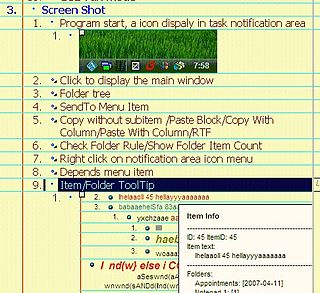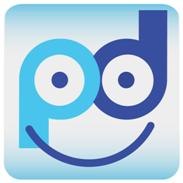Related Research Articles

Microsoft Outlook is a personal information manager software system from Microsoft, available as a part of the Microsoft Office suite. Though primarily an email client, Outlook also includes such functions as calendaring, task managing, contact managing, note-taking, journal logging, and web browsing.

A SIM card, also known as subscriber identity module or subscriber identification module (SIM), is an integrated circuit intended to securely store the international mobile subscriber identity (IMSI) number and its related key, which are used to identify and authenticate subscribers on mobile telephony devices. It is also possible to store contact information on many SIM cards. SIM cards are always used on GSM phones; for CDMA phones, they are needed only for LTE-capable handsets. SIM cards can also be used in satellite phones, smart watches, computers, or cameras.

An address book or a name and address book is a book or a database used for storing entries called contacts. Each contact entry usually consists of a few standard fields. Most such systems store the details in alphabetical order of people's names, although in paper-based address books entries can easily end up out of order as the owner inserts details of more individuals or as people move. Many address books use small ring binders that allow adding, removing and shuffling of pages to make room.
Network switching subsystem (NSS) is the component of a GSM system that carries out call out and mobility management functions for mobile phones roaming on the network of base stations. It is owned and deployed by mobile phone operators and allows mobile devices to communicate with each other and telephones in the wider public switched telephone network (PSTN). The architecture contains specific features and functions which are needed because the phones are not fixed in one location.
GSM services are a standard collection of applications and features available over the Global System for Mobile Communications (GSM) to mobile phone subscribers all over the world. The GSM standards are defined by the 3GPP collaboration and implemented in hardware and software by equipment manufacturers and mobile phone operators. The common standard makes it possible to use the same phones with different companies' services, or even roam into different countries. GSM is the world's most dominant mobile phone standard.
Plaxo was an online address book that launched in 2002. It was a subsidiary of cable television company Comcast from 2008 to 2017. At one point it offered a social networking service.

Ecco Pro was a personal information manager software based on an outliner, and supporting folders similar to spreadsheet columns that allow filtering and sorting of information based upon user defined criteria.
The Motorola Q is a Windows Mobile smartphone first announced in the Summer of 2005 as a thin device with similar styling to Motorola's immensely popular RAZR. Motorola in a partnership with Verizon Wireless released the Q on May 31, 2006. A version for Sprint was released early in January 2007 and one for Amp'd Mobile in April 2007.
BlackBerry Enterprise Server designates the middleware software package that is part of the BlackBerry wireless platform supplied by BlackBerry Limited. The software and service connects to messaging and collaboration software on enterprise networks and redirects emails and synchronizes contacts and calendaring information between servers, desktop workstations, and mobile devices. Some third-party connectors exist, including Scalix, Zarafa, Zimbra, and the Google Apps BES Connector, although these are not supported by BlackBerry Limited. As of June 2018, BlackBerry Enterprise Server has been renamed to BlackBerry Unified Endpoint Manager (UEM).

Loopt was a company based in Mountain View, California, United States which provided a service for smartphone users to share their location selectively with other people. The service supported iPhone, BlackBerry, Android and Windows Phones. Loopt's services had more than five million registered users and partnerships with every major U.S. mobile phone carrier. Their applications offered a variety of privacy controls. In addition to its core features, users also had the ability to integrate Loopt with other social networks, including Facebook and Twitter.
Mobile local search is a technology that lets people search for local things using mobile equipment such as mobile phones, PDAs, and other mobile devices. Mobile local search satisfies the need to offer a mobile subscriber spontaneous access to near-position services and information such as businesses, products, events, restaurant, movie theatre or other local information. Mobile local search is the search and discovery of persons, places, and things within an identifiable space defined by distinct parameters. These parameters are evolving. Today they include social networks, individuals, cities, neighborhoods, landmarks, and actions that are relevant to the searcher's past, current, and future location. These parameters provide structure to vertically deep and horizontally broad data categories that can stand-alone or are combined to comprise searchable directories.
Rich Communication Services (RCS) is a communication protocol between mobile telephone carriers and between phone and carrier, aiming at replacing SMS messages with a text-message system that is richer, provides phonebook polling, and can transmit in-call multimedia. It is part of the broader IP Multimedia Subsystem. Google added support for end-to-end encryption for one-on-one conversations in their own extension.
MobileMe is a discontinued subscription-based collection of online services and software offered by Apple Inc. All services were gradually transitioned to and eventually replaced by the free iCloud, and MobileMe ceased on June 30, 2012, with transfers to iCloud being available until July 31, 2012, or data being available for download until that date, when the site finally closed completely. On that date all data was deleted, and email addresses of accounts not transferred to iCloud were marked as unused.
The LG VX9700 is a CDMA touch screen cell phone made by LG. The phone features touch screen navigation, a 3.2-megapixel camera with face recognition and many photo enhancing tools, a camcorder, customizable shortcut menus, handwriting recognition, and a multitask music player. The LG Dare is the third phone to have Rev. A technology - after the Sprint Mogul and Touch.
Exchange ActiveSync is a proprietary protocol designed for the synchronization of email, contacts, calendar, tasks, and notes from a messaging server to a smartphone or other mobile devices. The protocol also provides mobile device management and policy controls. The protocol is based on XML. The mobile device communicates over HTTP or HTTPS.

PicDial was a mobile service created by IQzone Inc. and based in Scottsdale, Arizona, United States. PicDial provides users with the ability to automatically see their friends' Facebook and MySpace profile pictures and status messages as Full Screen Caller ID on their mobile phone. The software automatically keeps contacts social networking information current, allowing the most recent profile pictures and status messages to be displayed on incoming and outgoing calls or texts. The PicDial application provides users with a "Favorites Screen," a visual grid that allows users to call or text by selecting a friends social networking profile picture. This Mobile social address book platform allows users to link multiple social networks. The application also enables users to determine which picture will display when a call or text is made to a PicDial friend, giving the user control over the picture seen by friends. This defined picture can either be taken from the users camera on the phone, or pulled from their profile pictures on Facebook or MySpace. When a user changes their picture, this new image will be updated to their friends' phones.

GroupWise is a messaging and collaboration platform from Micro Focus that supports email, calendaring, personal information management, instant messaging, and document management. The GroupWise platform consists of desktop client software, which is available for Windows,, and the server software, which is supported on Windows Server and Linux.

Google Sync was a file synchronization service from Google that provided over-the-air synchronization of Gmail, Google Contacts, and Google Calendar with PC and mobile device Mail, Calendar and Address Book applications. It used Microsoft® Exchange ActiveSync® to let service users synchronize their Google Apps mail, contacts, and calendars to their mobile devices, wherein the users can also set up or customize the alerts for incoming messages and upcoming meetings. Google Sync worked with PC, Mac, Linux, Android, BlackBerry, Symbian S60, iPhone, iPad, Windows Mobile, and other devices. Google Sync was announced in February 2009 and discontinued for non-business users in December 2012.

Fuze is a cloud communications and collaboration software platform designed for the enterprise. The company is headquartered in Boston, Massachusetts.